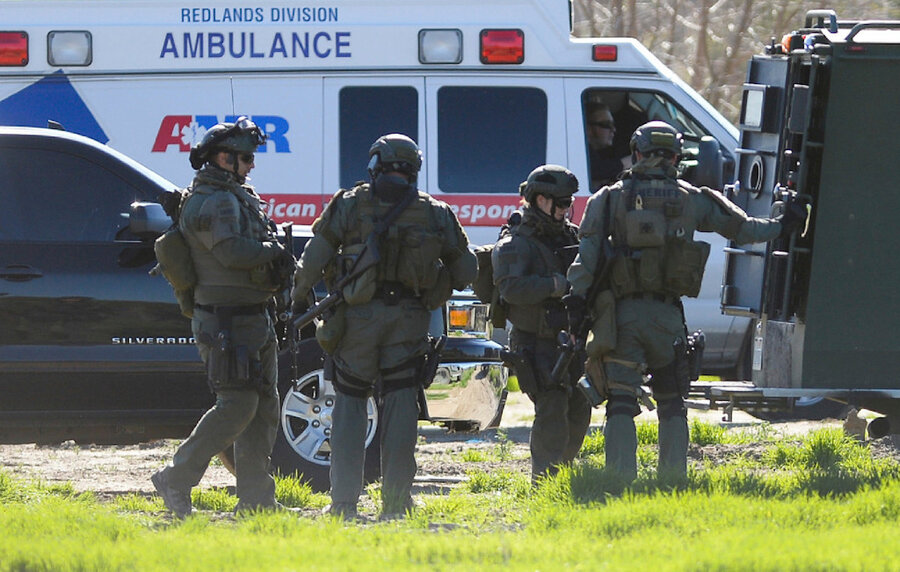How origami shield could provide 'revolutionary' police protection
Loading...
When mechanical engineering professor Larry Howell began work on a new ballistic shield, police officers told him that their current gear was “kind of medieval.”
“Most of them are still basically just … a big chunk of steel with handles on it, and so they tend to be very heavy,” he tells The Christian Science Monitor in a phone interview. Many of them weigh nearly 100 pounds.
But a new folding kevlar shield, developed by Professor Howell, his colleague Terri Bateman, and other faculty and graduate students at Brigham Young University, weighs 55 pounds, fits in the trunk of a car, unfolds in seconds, and covers more than one officer. It can also take a hit from a .44 Magnum handgun without ripping or tipping over.
Together, these features could make the shield much better-suited to police work than current technology.
“It's easily transportable, and it provides protection for more than one officer,” says Chuck Wexler, executive director of the Police Executive Research Forum, after watching video of the shield in action. “So I think that if the test results hold up, this could be an important option for police departments to consider.”
The BYU team derived these advantages from an unlikely source. “Origami artists, over the centuries, had discovered interesting ways to achieve motion that we wouldn't have discovered using our traditional engineering approaches,” Howell explains.
His past work has used origami techniques to shrink NASA payloads and medical devices. Through discussions with federal agents and local police, “We realized that having a compact bulletproof barrier that's easy to transport, easy to stow, and then deploys very quickly, and is light, has a lot of benefits.”
“It seems kind of weird that you could go from origami … to something that's bulletproof,” Howell acknowledges. But by applying a Yoshimura fold pattern to a sheet with 12 layers of Kevlar – plus an aluminum core for stability – the researchers created a shield that can withstand hits from 9-millimeter, .357 Magnum, and .44 Magnum pistols.
A federal agent involved in the testing “said that it was revolutionary,” Howell remembers.
The recent uptick of active-shooter incidents has created a need to better protect officers. Police once tried to contain a gunman until heavily armed SWAT officers could respond. The 1999 Columbine shooting prompted a change in strategy, and “patrol officers are being trained to respond to active shooters as quickly as possible,” according to a 2014 report by the Police Executive Research Forum (PERF).
Not surprisingly, such “solo entries” place cops in extreme danger; the same PERF report found that, between 2000 and 2010, one-third of officers entering an area with an active shooter got shot.
To increase officers’ safety and odds of success, PERF recommends keeping shields and other equipment “on the road, not in a closet.” Mr. Wexler thinks that the shield’s small size and low weight could be conducive to this end. “It's important to have something that police departments can fit in their [car’s] trunk.”
BYU's Howell thinks that it could also be kept tucked away in schools for quick deployment against an active shooter.
But Captain Greg Meyer (Ret.), a nationally recognized use-of-force expert who researched several nonlethal weapons for the LAPD, sees a narrower role for the new shield. “My first impression is that a device like this would be most useful to a SWAT team or in some cases anti-riot squads,” he tells the Monitor in an email.
“It may not be much use to a regular patrol officer, as the incidents that result in gun fire involving patrol officers tend to occur very rapidly, with no warning, with no opportunity to deploy such a device.”
However, Captain Meyer encouraged “further research and testing,” and Howell points out that the shield is at least 18 to 24 months away from mass production.
Further development could also resolve some of its limitations. The current version can’t take hits from assault rifles – although according to Wexler, police officers take fire from handguns much more often – and uses $800 to $1,000 worth of materials, Howell estimates.
Howell expects mass production to bring down costs. The team is also investigating a smaller, individual version, and incorporating “exotic materials” – such as synthetic spider-silk and metallic foam – that could make it stronger.
In whatever form this new shield hits the streets, it’s likely to be welcomed by tactical experts like Wexler.
In “any situation where it appears where someone might have a gun,” he says, “giving officers more options for their protection is advantageous.”
Howell agrees. "Let's say you've got a bad guy or a sniper or whatever holed up in this area. You're setting up a command station. Right nearby, you'd like to have protection, and ideally you'd like to be able to do that quickly."








